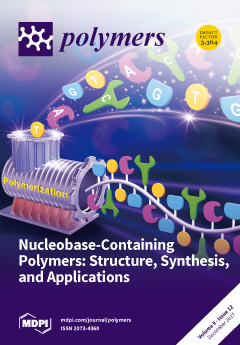Ten coordination polymers constructed from divalent metal salts, polycarboxylic acids, and bis-pyridyl-bis-amide ligands with different donor atom positions and flexibility are reported. They were structurally characterized by single-crystal X-ray diffraction. The ten coordination polymers are as follows: (
1) {[Ni(
L1)(3,5-PDA)(H
2O)
3]·2H
2O}
n (
L1 =
N,
N′-di(3-pyridyl)suberoamide, 3,5-H
2PDA = 3,5-pyridinedicarboxylic acid); (
2) {[Ni
2(
L1)
2(1,3,5-HBTC)
2(H
2O)
4]·H
2O}
n (1,3,5-H
3BTC = 1,3,5-benzenetricarboxylic acid); (
3) {[Ni(
L2)(5-
tert-IPA)(H
2O)
2]·2H
2O}
n (
L2 =
N,
N′-di(3-pyridyl)adipoamide, 5-
tert-H
2IPA = 5-
tert-butylisophthalic acid); (
4) [Ni(
L3)
1.5(5-
tert-IPA)]
n (
L3 =
N,
N′-di(4-pyridyl)adipoamide); (
5) [Co(
L1)(1,3,5-HBTC)(H
2O)]
n; (
6) {[Co
3(
L1)
3(1,3,5-BTC)
2(H
2O)
2]·6H
2O}
n; (
7) [Cu(
L4)(AIPA)]
n (
L4 =
N,
N′-bis(3-pyridinyl)terephthalamide, H
2AIPA = 5-acetamido isophthalic acid); (
8) {[Cu(
L2)
0.5(AIPA)]·MeOH}
n; (
9) {[Zn(
L4)(AIPA)]·2H
2O}
n; and (
10) {[Zn(
L2)(AIPA)]·2H
2O}
n. Complex
1 forms a 1D chain and
2 is a two-fold interpenetrated 2D layer with the
sql topology, while
3 is a 2D layer with the
hcp topology and
4 shows a self-catenated 3D framework with the rare (4
2·6
7·8)-
hxg-d-5-C2/c topology. Different Co/1,3,5-H
3BTC ratios were used to prepare
5 and
6, affording a 2D layer with the
sql topology and a 2D layer with the (4·8
5)
2(4)
2(8
3)
2(8) topology that can be further simplified to an
hcp topology. While complex
7 is a 2D layer with the (4
2·6
7·8)(4
2·6)-3,5L2 topology and
8 is a 2-fold interpenetrated 3D framework with the
pcu topology, complexes
9 and
10 are self-catenated 3D frameworks with the (4
24·6
4)-8T2 and the (4
4·6
10·8)-
mab topologies, respectively. The effects of the identity of the metal center, the ligand isomerism, and the flexibility of the spacer ligands on the structural diversity of these divalent coordination polymers are discussed. The luminescent properties of
9 and
10 and their photocatalytic effects on the degradation of dyes are also investigated.
Full article






